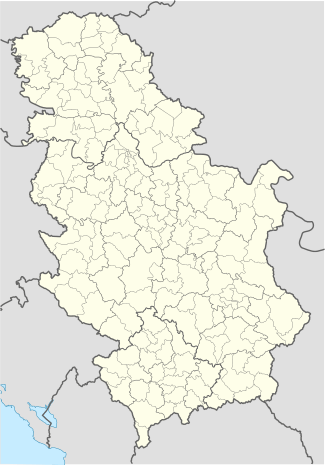Bačko Gradište
| Bačko Gradište Бачко Градиште Bácsföldvár | |
|---|---|
| Village | |
|
Main street with Catholic church in Bačko Gradište | |
 Bačko Gradište | |
| Coordinates: RS 45°32′N 20°2′E / 45.533°N 20.033°E | |
| Country |
|
| Province |
|
| Population (2002) | |
| • Total | 5,445 |
| Time zone | CET (UTC+1) |
| • Summer (DST) | CEST (UTC+2) |

Bačko Gradište (Serbian Cyrillic: Бачко Градиште, pronounced [bâːtʃkɔː ɡrâdiːʃtɛ]; Hungarian: Bácsföldvár, pronounced [ˈbaːt͡ʃføldvaːr]; German: Feldwar in der Batschau) is a village located in the Bečej municipality, in the South Bačka District of Serbia. It is situated in the Autonomous Province of Vojvodina. The village is ethnically mixed and its population numbering 5,445 people (2002 census). Largest ethnic groups in the village are Hungarians (46.26%) and Serbs (44.39%). Linguistically the village has a Slavophonic plurality as Serbs, Yugoslavs, Croats, Montenegrins and Muslims by nationality collectively compose 49.35% of the population. In early 2007, the village was, among others, affected by the measles outbreak that attracted WHO attention.
History
Former Serbian name of this village was Feldvarac (Фелдварац). Historical sources from 1316 mentioned several settlements with name Feldvarac, but it is not sure which one of those could be identified with modern village. More reliable data about this settlement are dated in the period of Ottoman administration (16th-17th century). According to Habsburg census from 1720, this village was populated exclusively by Serbs,[1] while 1910 census recorded that speakers of Hungarian language are more numerous than speakers of Serbian in this settlement.[2]
Ethnic groups (2002 census)
The population of the village include:
- 2,519 (46.26%) Hungarians
- 2,417 (44.39%) Serbs
- 151 (2.77%) Yugoslavs
- 67 (1.23%) Croats
- 51 (0.94%) Roma
- 40 (0.74%) Montenegrins
- 12 (0.22%) Muslims by nationality
- others
Historical population
- 1961: 6,106
- 1971: 5,986
- 1981: 5,764
- 1991: 5,625
Tourism
Bačko Gradište is very popular because of its Oxbow lake. There is a settlement of holiday houses there -without electricity- because the town doesn't want it to become an official village. People from Novi Sad, Belgrade, Temerin, Bečej, and Vrbas have houses here and they spend their time here on weekends, because it is very relaxing and far away from the urban life.
On 1 May there is a huge holiday at the oxbow lake, where even people from neighbouring countries (Hungary) come to enjoy the nature.
Sports
- FC. Vojvodina Bačko Gradište was formed in 1913. This is one of the oldest football clubs in the territory of ex-Yugoslavia. The club hasn’t ceased to exist since 1913. In the year of 2008 the club will celebrate 95 years of constant competing and the team is planning to celebrate it by winning the championship. Today FC. Vojvodina is competing in The Municipal League of Vrbas-Srbobran-Bečej.
- The club has a very good quality pitch, covered stands and very good dressing rooms. It is also planning to open a restaurant near the pitch in 2008.
- The atmosphere in FC. Vojvodina Bačko Gradište is very good. All of the players who played in other clubs have come back in 2007 and they have enhancements from Bečej and Novi Bečej. After every practice and every match the team stays in the restaurant where they enjoy each other's company, where the best scorer has to buy a crate of beer.
See also
Notes
- ↑ Ivan Jakšić, Iz popisa stanovništva Ugarske početkom XVIII veka, Novi Sad, 1966, page 365.
- ↑ "Archived copy". Archived from the original on 2011-10-07. Retrieved 2011-06-28.
References
- Slobodan Ćurčić, Broj stanovnika Vojvodine, Novi Sad, 1996.
External links
| Wikimedia Commons has media related to Bačko Gradište. |
- Bačko Gradište web site
- History of Bačko Gradište (Hungarian)
Coordinates: 45°32′N 20°02′E / 45.533°N 20.033°E
